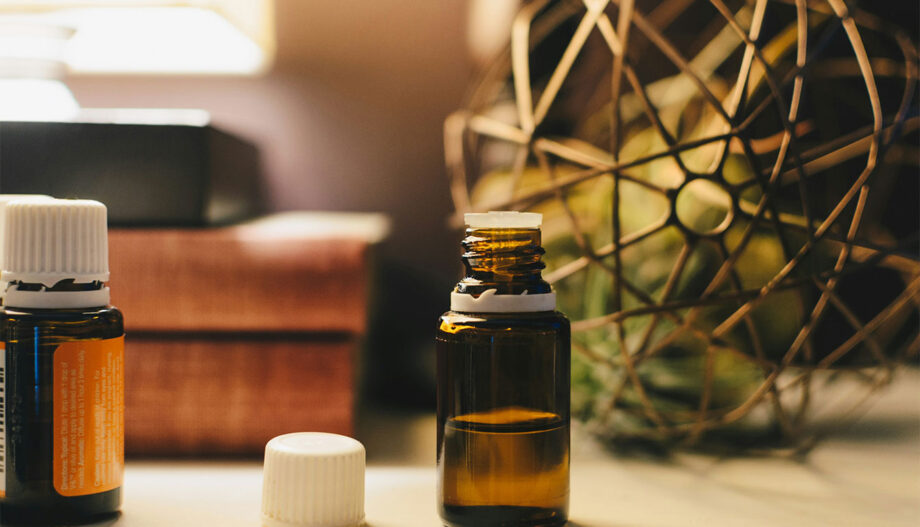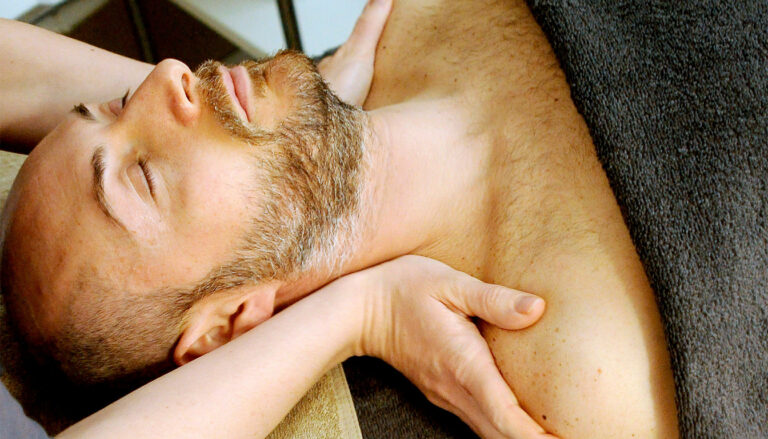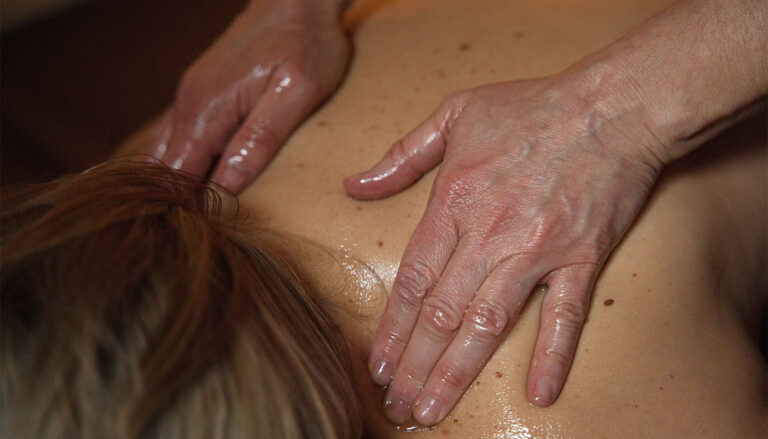Sciatica is a common reason for back pain and leg discomfort in the UK. Around 80% of people will have a lower back issue at some point, often from strained muscles, ligaments or tendons that usually heal over time.
Soft-tissue bodywork aims to relax tight tissue, restore movement and support local blood flow. Some clinicians add essential oils to their blends as an adjunct to hands-on therapy, hoping to ease symptoms without hindering the body’s natural healing.
If tingling, numbness or weakness appear, seek assessment rather than self-treating. This guide looks at realistic benefits, limits and safe ways to try combined approaches. It sets out practical steps, safe dilution notes and alternatives when hands-on work is not suitable.
Read on to learn what the evidence says, where essential oils may fit, and when to consult a professional so you can make informed choices while the back and related tissue recover.

Key Takeaways
- Sciatica often starts in the lower back and may improve as tissues heal naturally.
- Bodywork can relax tight tissue, improve circulation and ease nerve pressure.
- Essential oils are adjuncts to hands-on therapy, not stand-alone cures.
- Serious symptoms such as weakness or persistent numbness need professional assessment.
- Practical, safe application and realistic expectations help manage discomfort while healing.
Understanding sciatica today: what it is, common causes, and symptoms
The term sciatica describes a pattern of pain and nerve-related symptoms that follow the course of the sciatic nerve from the lower spine, through the buttock and down one leg. It commonly affects one side and can vary from sharp twinges to a dull ache with tingling or numbness.
What the sciatic nerve does and how it affects the lower back
The sciatic nerve links the spinal cord to areas of the leg and foot, so irritation near the spine can cause referred symptoms downstream. When nerves face extra pressure, nearby tissues may swell and function can be impaired.
Mechanical and non-mechanical triggers
Mechanical causes include a herniated disc, spinal stenosis, spondylolisthesis, degenerative disc disease, vertebral fracture, bone spur or muscle spasm that raises local pressure. Non-mechanical contributors such as pregnancy, excess weight and poor posture can also trigger symptoms by changing how the body loads the spine.
Typical signs to watch for
Typical symptoms include sharp or aching back and leg pain, pins and needles, numbness and occasional weakness. Most mild to moderate episodes improve within about three months with movement, heat or ice, exercise and gentle deep tissue work to boost circulation.
See a doctor promptly if you get severe weakness, new numbness, or if lower back pain and leg symptoms do not ease after several weeks. Early sensible care can reduce pressure on sensitive structures and support recovery.
| Aspect | Common examples | Typical effect |
|---|---|---|
| Mechanical causes | Herniated disc, spinal stenosis, bone spur | Direct nerve compression, referred pain |
| Non-mechanical contributors | Pregnancy, obesity, poor posture | Altered loading, increased strain on tissues |
| Usual symptoms | Pain, tingling, numbness, weakness | Reduced standing/walking function |
Is aromatherapy massage good for sciatic pain?
Aromatherapy massage eases the short-term discomfort that follows nerve irritation in the lower back.
What the evidence and experts suggest
Research shows manual treatment can reduce symptoms. A 2014 clinical trial found deep tissue sessions (30 minutes, daily over two weeks) matched NSAIDs for some low back conditions.
How manual work may help
Treatment can ease tight muscles around the lower back and hip, which may lower pressure on the sciatic nerve and related structures.
Improved local blood flow supports tissue comfort. Hands-on approaches also trigger endorphin release, which raises pain thresholds and helps people keep moving during flare-ups.
Where essential oils fit
Essential oils are used as adjuncts blended into carrier oils to complement techniques aimed at relief and relaxation. Common choices include lavender for calm and peppermint for a cooling effect.
Discuss options with a qualified therapist if you have recent injury, complex back issues or other health concerns. Remember, these approaches usually give short- to medium-term relief while underlying causes are addressed.
| Benefit | Typical effect | When useful |
|---|---|---|
| Muscle easing | Less tension around nerves | Flare-ups with tight hips or gluteal muscles |
| Circulation boost | Improved local blood supply | Stiff or sore lower back |
| Symptom relief | Higher tolerance of daily activities | Short- to medium-term management |
How aromatherapy massage may help: benefits, limits, and realistic expectations
Targeted bodywork can ease tense muscles, boost local circulation and reduce referred symptoms along the leg. These effects may help reduce pain and improve movement while underlying issues recover.
Potential benefits
Calms overactive muscles, lowering spasm that raises pressure on nearby nerves. This often leads to easier walking and daily tasks.
Improves blood flow, which can speed tissue healing and reduce stiffness. Some people report better relaxation and short-term symptom reduction.
Limits and realistic expectations
Therapy addresses soft tissues and nervous system modulation. It does not repair structural problems such as a herniated disc or marked spinal narrowing. Use it as part of a wider treatment plan.
Common techniques and self-care
Practitioners may use deep tissue, neuromuscular work, myofascial release or selected Swedish strokes, each adapted to tolerance. Alternating heat and ice during flares, plus gentle stretches and strengthening, helps control current and future episodes.
| Goal | Typical method | When useful |
|---|---|---|
| Reduce muscle spasm | Deep tissue or neuromuscular | Acute tightness in lower back and gluteal area |
| Improve circulation | Swedish strokes and gentle mobilisation | Stiff or aching lower back |
| Release fascial tension | Myofascial techniques | Persistent referred symptoms down the leg |
| Support rehab | Combined therapy plus exercise | Recovery phase and recurrence prevention |
Keep activity paced and seek reassessment if symptoms persist or worsen. Many mild to moderate episodes settle over weeks with sensible care and movement.
How to try it safely at home: essential oils, blends and massage tips
A cautious, stepwise home routine can calm tense muscles and support local blood flow in the lower back and down the leg. Start with simple blends and short sessions. Check skin sensitivity with a patch test before wider use.
Choosing oils
- Lavender — soothing and anti-inflammatory.
- Peppermint — cooling; avoid in pregnancy and test skin first.
- Black pepper — warming and circulatory; not for pregnancy.
- Wintergreen, rosemary, marjoram, eucalyptus and ginger also offer supportive effects.
Carrier oils and safe dilutions
Use castor or arnica-infused carrier oils to aid absorption and comfort. Blend 3–5 drops of essential oils into 1/2–1 teaspoon carrier for local application.
Maximum guide: about 10 drops per teaspoon on small areas. Avoid wintergreen, black pepper, castor and arnica during pregnancy.
Simple step-by-step
- Mix fresh blend and warm a small amount between your palms.
- Apply with gentle strokes to the lower back, buttock and down the back of the leg, avoiding direct pressure on acutely tender spots.
- Use light to moderate techniques for 5–10 minutes, once or twice daily, and combine with posture checks and gentle movement.
Alternatives when hands-on work isn’t suitable
Try a warm bath with up to 10 drops of oil dispersed in a carrier, or alternate warm and cold compresses to influence circulation and relaxation.
Further reading: practical oil blends and safety notes are available in this guide on natural remedies for lower back issues, and this article explains how professional massage therapy can help a pinched.
Working with a qualified massage therapist in the UK
Choose a regulated practitioner to ensure safe standards. Start with your GP if you need guidance or a formal referral. Many doctor surgeries can point you to local clinics or physiotherapy services that work with experienced therapists.
Finding a practitioner: GP referrals, professional registers and credentials
Verify membership of recognised registers such as the CNHC or relevant professional bodies. Ask whether the therapist lists experience treating sciatica and lower back pain, and which types of treatment they use most often.
What to discuss before treatment: symptoms, triggers, existing conditions and goals
Be open and precise. Tell the therapist about prior imaging, recent triggers, medications and other health conditions. This helps them adapt techniques and avoid sensitive areas.
- Confirm session length, location, fees and any concession rates.
- State clear goals: improved function when walking or sitting, fewer flare-ups, or support alongside rehab.
- Ask if they work with your doctor or other therapists and how they manage consent and hygiene.
| Check | Why it matters | What to ask | When useful |
|---|---|---|---|
| Professional register | Ensures standards and insurance | Which body are you registered with? | Before first appointment |
| Experience with sciatica | Technique selection and safety | Which types do you use (Swedish, deep tissue, neuromuscular)? | When symptoms affect walking or sitting |
| Health disclosure | Avoids adverse reactions | Do you need details of imaging or meds? | When there are existing conditions |
| Blend and dilution | Allergy and skin-sensitivity safety | Which carrier oil and dilution will you use? | If oils are offered in treatment |
Conclusion
Combining practical self-care with professional treatment often speeds functional gains during a flare-up. Gentle hands-on work can calm tense tissue and reduce perceived symptoms, giving short-term relief while the body heals.
Use it as a supportive option, not a cure. Pair targeted exercise, posture changes and sensible activity to address common triggers and improve back function over weeks.
Seek medical assessment if neurological signs, worsening weakness or persistent symptoms appear. Many episodes settle within about three months; surgery is sometimes considered after roughly 12 weeks if conservative care fails.
Track what helps you most — specific techniques, blends or simple routine changes — and work with a qualified therapist and your GP to personalise ongoing therapy and healing plans.
FAQ
What exactly is sciatica and how does the sciatic nerve affect the lower back and leg?
Sciatica occurs when the sciatic nerve, which runs from the lower spine down each leg, becomes irritated or compressed. That irritation can cause sharp pain, tingling, numbness or weakness that usually affects one side. Symptoms often start in the lower back or buttock and travel down the back of the thigh into the calf and foot.
Which conditions commonly cause sciatica?
Mechanical problems such as a herniated disc, spinal stenosis or spondylolisthesis frequently compress the nerve. Non‑mechanical factors include poor posture, pregnancy, piriformis muscle spasm and prolonged sitting. Age‑related wear and tear and previous lumbar injury can also contribute.
What signs suggest sciatica rather than general lower back discomfort?
Sciatica typically produces radiating pain down one leg, associated numbness, pins and needles or muscle weakness. Pain that worsens when coughing, sneezing or bending and pain concentrated along the back of the thigh and calf points to nerve involvement rather than simple muscular soreness.
Can massage therapy help with nerve‑related lower back and leg symptoms?
Many physiotherapists and massage therapists report symptom improvement after targeted therapy. Manual techniques can calm tight muscles, ease trigger points and improve local circulation, which may reduce pressure on nerve roots and lessen radiating discomfort. Results vary with cause and severity.
How do essential oils complement hands‑on treatment?
Selected essential oils such as lavender, peppermint, rosemary or ginger may add relaxation, a cooling or warming sensation and modest anti‑inflammatory effects when diluted properly. They can enhance comfort and reduce stress during treatment but should never replace clinical care for serious nerve compression.
What realistic benefits should I expect from a session?
Expect short‑term relief of muscle tension, reduced local soreness and improved mobility in many cases. Some people notice fewer flare‑ups and better sleep after regular sessions. However, manual therapy usually eases symptoms rather than cures an underlying structural problem.
Which manual techniques suit nerve‑related symptoms best?
Deep tissue work, neuromuscular therapy, myofascial release and Swedish techniques can all help depending on individual findings. A therapist will tailor depth and pressure to avoid aggravating nerve irritation while releasing tight tissues around the pelvis and lumbar spine.
Are there limits or risks to trying topical oil blends and home treatment?
Yes. Incorrect dilution, skin sensitivity or inappropriate pressure can worsen irritation. People with anticoagulant medication, diabetes, pregnancy or active infection should take extra care. If symptoms include progressive weakness, bowel or bladder changes, seek urgent medical assessment.
Which carrier oils and dilutions are safe for use on the lower back and leg?
Common carriers include sweet almond, grapeseed and fractionated coconut oil. A conservative dilution is 1–2% essential oil for adults (about 6–12 drops per 30ml carrier). Arnica oil may help bruising and castor oil aids circulation, but always patch‑test first.
How should I prepare a simple blend and apply it safely at home?
Choose one or two suitable essential oils, dilute to 1% in a carrier, warm the blended oil in your hands and use gentle, short strokes over the lower back, buttock and outer thigh. Avoid deep, aggressive pressure directly over the spine. Stop if numbness or sharp radiating pain increases.
What self‑care complements hands‑on treatment?
Gentle mobilisation, core and glute strengthening exercises, heat or cold packs as needed, posture adjustments and short walking sessions often help. Combine these with treatment sessions and advice from a physiotherapist for best results.
When should I avoid hands‑on therapy and seek medical care instead?
Seek prompt medical review if you develop progressive weakness in the leg, loss of bowel or bladder control, high fever, unexplained weight loss or severe worsening pain. Also consult a GP before treatment if you have recent cancer, blood‑clotting issues or are on blood thinners.
How can I find a qualified practitioner in the UK?
Ask your GP for a referral, or search professional registers such as the Chartered Society of Physiotherapy, the Complementary and Natural Healthcare Council (CNHC) or the Federation of Holistic Therapists. Check qualifications, insurance and client reviews before booking.
What should I discuss with a therapist before treatment?
Describe your symptoms, onset, triggers, previous diagnoses, medication and any red‑flag signs. Agree treatment goals and preferred techniques, explain essential‑oil sensitivities and confirm the therapist’s experience with nerve‑related conditions.





